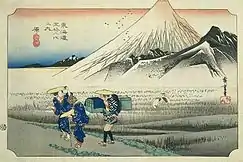
Hara-juku in the 1830s, as depicted by Hiroshige in the Hōeidō edition of The Fifty-three Stations of the Tōkaidō (1831–1834)
Hara-juku (原宿, Hara-juku) was the thirteenth of the fifty-three stations of the Tōkaidō. It is located in the present-day city of Numazu, Shizuoka Prefecture, Japan.
History
Hara-juku was a smaller post town on the coast of Suruga Bay between Numazu-juku and Yoshiwara-juku in Suruga Province. It is the site of many paintings because of Mount Fuji in the background.[1]
The classic ukiyo-e print by Andō Hiroshige (Hōeidō edition) from 1831 to 1834 depicts two women travelers walking past a huge snowy Mount Fuji. The women are accompanied by a manservant who is carrying their luggage. By contrast, the Kyōka edition of the late 1830s depicts three small teahouses, dwarfed by a huge, red Mount Fuji which protrudes out of the picture into the top margin.
Neighboring post towns
- Tōkaidō
- Numazu-juku - Hara-juku - Yoshiwara-juku
References
Wikimedia Commons has media related to Hara-juku.
- Carey, Patrick. Rediscovering the Old Tokaido:In the Footsteps of Hiroshige. Global Books UK (2000). ISBN 1-901903-10-9
- Chiba, Reiko. Hiroshige's Tokaido in Prints and Poetry. Tuttle. (1982) ISBN 0-8048-0246-7
- Taganau, Jilly. The Tokaido Road: Travelling and Representation in Edo and Meiji Japan. RoutledgeCurzon (2004). ISBN 0-415-31091-1
- ↑ Hara-juku to Yoshiwara-juku. Accessed November 7, 2007.
This article is issued from Wikipedia. The text is licensed under Creative Commons - Attribution - Sharealike. Additional terms may apply for the media files.